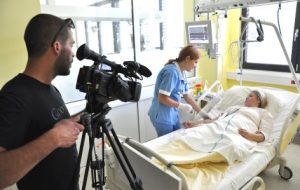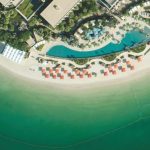The young country is an emerging destination for those looking for excellence in treatment abroad at a very affordable price
Slovenia marked its 20 years of independence in 2011 and is a young, growing and optimistic piece of Europe. Covered in green, the country inspires everyone that puts a foot on its soil. Over the millennia, Slovenia has maintained this green image and the perfect environment that seems to be treating itself. Over the centuries the locals have learned how to listen to the wisdom of nature, which left its mark on the modern medical methods.
Abundant natural resources and numerous springs of medicinal waters turned Slovenia in the land of spas. In addition, the high quality services of experienced and world-renowned experts in medicine, modern surgical nursing homes and providers of specialist reviews are the proof that enviable medical tradition of Slovenia reaches the top of the world. The country is marked by a significant biological diversity and is known to be one of the most water-rich countries in Europe.
The economy of Slovenia is small, open and export-oriented and has been strongly influenced by international conditions as it was severely hurt by the Eurozone crisis, which started in the late 2000s. The main economic field is services, followed by industry and construction.
Healthcare sector
Slovenia’s people have actually learned how to listen to the nature over the centuries that even today enriches recognized treatment methods all around the world. Due to its rich natural resources and countless springs of healing water, Slovenia is filled with spas where services are provided by experienced and world renowned medical professionals. Modern surgical clinics and providers of specialist examinations prove that that impressive medical tradition of Slovenia is one of the best in the world.
Healthcare in Slovenia is a public service provided through the public health service network. This network also includes, on an equal basis, other institutions, private physicians and other private service providers on the basis of concessions. With relatively limited public funds available for this purpose, the level of healthcare in Slovenia is entirely comparable with the level of health care in the advanced countries of Europe.
In Slovenia the system of health insurance is divided into compulsory health insurance, voluntary health insurance for additional coverage, and insurance for services that are not a constituent part of compulsory insurance.
Primary healthcare services are organized locally, such that they are equally accessible to all people without discrimination. Everyone must be assured continuously accessible urgent medical attention and emergency services. Compulsory health insurance is mandatory for all citizens with permanent residence in Slovenia, whereby everyone is bound to pay contributions under the solidarity principle. Compulsory insurance does not, however, ensure the coverage of all costs that arise in treatment. Complete coverage of costs is provided only for children, schoolchildren and for certain illnesses and conditions.
For the provision of voluntary health insurance, in 1999 a new Mutual Health Insurance organization was established. It is owned by its members – insured persons – and operates according to the principles of mutuality and non-profit status. Other insurance companies can offer voluntary health insurance, provided that it is organized as long-term insurance, that they insure everybody, irrespective of their state of health, and that the insurance company makes no distinctions between those insured.
Therapeutic factors
The emphasis on a healthy lifestyle at Slovenia’s natural spas is based on a centuries-long tradition of thermal treatments and experience in the fields of balneology, climatology, and thalassotherapy. Their holistic approach to treating guests revives several long forgotten forms of treatment and respects the experience of traditional medicine from distant countries. Excavations from the period of the Roman Empire bear witness to Slovenia’s rich and diverse culture of thermal baths, documents from as early as 1147 describe the use of thermal springs, and research has demonstrated the healing qualities of its mineral waters that have been appreciated for centuries.
Modern natural spa tourist centers have become one of the most outstanding elements of Slovenia’s tourist offer. Their increasing focus on developing a broader tourist and recreation offer has led to their redefinition as ‘thermal spas’ and ‘wellness centers.’ Numerous innovations in their offer reflect their dynamism and their openness to adapting to new trends in spa and leisure time tourism. At the same time, they have welcomed and incorporated ideas about “health resorts for the healthy,” about creating entertaining water recreation parks for tourists, and about combining centuries of tradition and experience in balneology with some lesser known Eastern philosophies and methods of treatment that add additional charm and attractiveness to their offer.
Medical tourism
Slovenia is a country with excellent climatic conditions and unique natural and architectural treasures. But, in addition to the beautiful landscape, Slovenia attracts the attention of hundreds of thousands of tourists every year, as here the most famous spa resorts in Europe, where the use of mud and thermal mineral water is common, are located.
The sphere of medical tourism in Slovenia is represented by state and private multi-field medical centers, specialized private clinics, as well as resorts offering balneological treatment applying unique natural healing factors. Foreign patients having chosen Slovenia for checkup, treatment, and recovery expect to find professional medical personnel, high standards of medical attendance, and liberal pricing policy. Many local medical institutions cooperate with world-leading medical centers and professionals.
Among foreign nationals, the highly demanded medical fields include: Dentistry (surgical and aesthetic dentistry, implantology, prosthetics) – Plastic surgery (rhinoplasty, liposuction, contour face lift, blepharoplasty, menthoplasty, othoplasty) – Metabolism disorders treatment (obesity, diabetes) – Hematology / blood diseases – Heart diseases – Skin diseases – Cardiology – Neurology – Orthopedics (complex surgeries of hip and knee joint replacement, rehabilitation after traumas of musculoskeletal apparatus).
Special rehabilitation courses after surgeries and traumas are offered at the following balneological resorts of Slovenia: Čatež (Chatezh), Rogaška Slatina, Dobrna, Strunjan, Trenčianske Teplice, Bardejovske kupele. Natural healing factors and mineral waters allow the successful treatment of such diseases as: diseases of neurological nature, of respiratory organs, musculo-skeletal apparatus, gastroenterological and cardio-vascular diseases, male and female infertility, allergic reactions and skin problems, relieve chronic aches in the spine and joints. Balneological treatment is conducted necessarily under the doctor’s supervision and brings about excellent rehabilitation of patients.
Slovenia is an emerging destination for those looking for excellence in treatment abroad at a very affordable price, even if an extensive or complex procedure is required. More than ten thermal spas, at which a huge number of diseases of the internal organs and the musculoskeletal system are treated, are located in Slovenia. The most famous resorts are: Rogaska Slatina, Terme Donelske Toplice, Terme Smarjeske Toplice, Thalasso Strunjan, Terme Catez, Terme Olimia, Terme 3000, Dobrna, Radenci and Portoroz.
World Heritage Committee
At the 41st session of World Heritage Committee in Krakow, Poland, the United Nations Educational, Scientific and Cultural Organisation (UNESCO) has inscribed 63 new areas of ancient and primeval beech forest in 10 countries onto the World Heritage List. Among them are two areas in Slovenia: the Krokar virgin forest and the Snežnik-Ždrocle forest reserve.
The Krokar virgin forest is an example of untouched primeval forest in the heart of the well-preserved forests of the Kočevje region, which is also part of the Natura 2000 network in Slovenia. The Snežnik-Ždrocle forest reserve consists of ancient beech forest with sections of primeval forest. Like Krokar, it lies within a larger forest area that is included in the Natura 2000 network. Addition to the list represents recognition for Slovenia and a commitment to further enhance the protection of both forest reserves and other beech forest ecosystems in the future.
The primeval beech forests of Krokar and Snežnik-Ždrocle joined the Škocjan Caves on the UNESCO World Heritage List. The caves, inscribed 30 years ago, were up to now the only natural monument in Slovenia on the UNESCO list.
Slovenia’s beech forests will appear on the list alongside forests of already acknowledged outstanding universal value in Germany, Ukraine and Slovakia, which together form the World Heritage site Primeval Beech Forests of the Carpathians and the Ancient Beech Forests of Germany. The list is completed by areas in Albania, Austria, Belgium, Bulgaria, Italy, Romania, Spain, Ukraine, Slovakia and Croatia.














